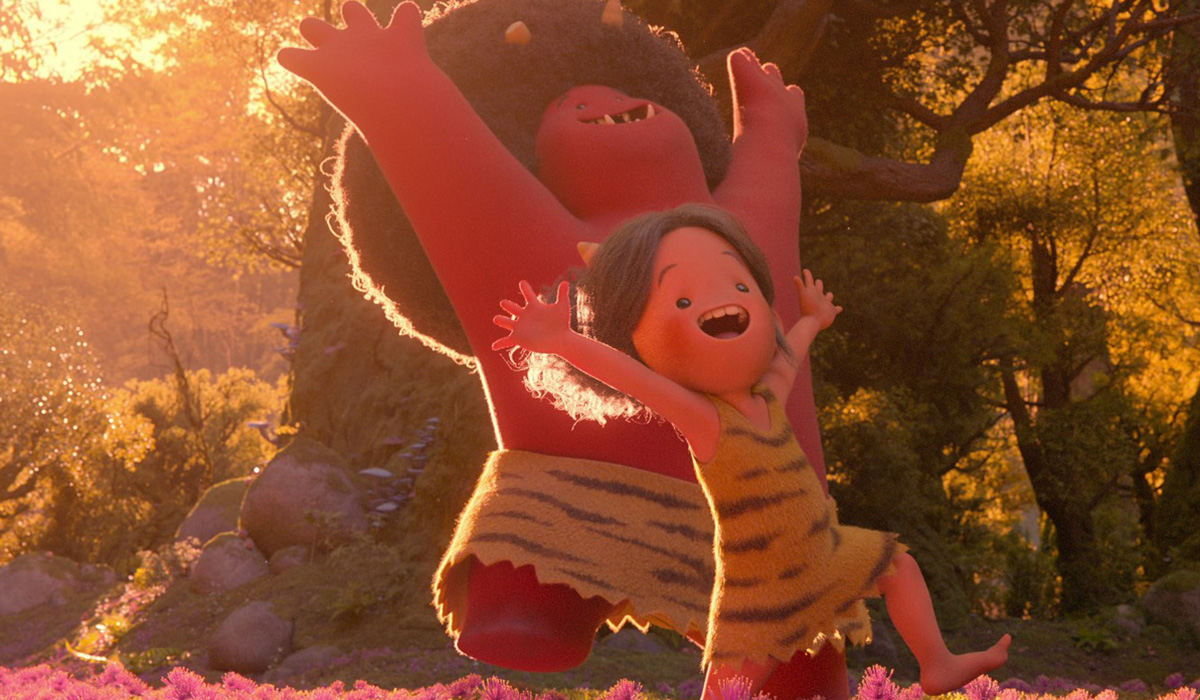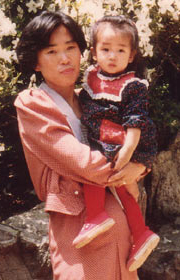 Hyun-Min Lee, an animator from Seoul, South Korea, came to the United States in 2000, earning a degree in painting from Wesleyan University and a Masters degree in animation from the California Institute of the Arts. Although she enjoys working in all areas of animation, her work mainly focuses on traditional hand drawn techniques and she cites the early Disney films as an influence on her work. Following time spent training with animators Eric Goldberg and Bert Klein, Hyun-min embarked on her own traditionally animated short film, The Chestnut Tree, in memory of her mother [pictured right with Hyun-Min]. The film uses a traditionally hand-drawn technique, preserving a rough line style with a watercolor wash for color, animated in sync to a classical piece by Chopin, centering around a little girl and her mother as they revisit memories under a chestnut tree.
Hyun-Min Lee, an animator from Seoul, South Korea, came to the United States in 2000, earning a degree in painting from Wesleyan University and a Masters degree in animation from the California Institute of the Arts. Although she enjoys working in all areas of animation, her work mainly focuses on traditional hand drawn techniques and she cites the early Disney films as an influence on her work. Following time spent training with animators Eric Goldberg and Bert Klein, Hyun-min embarked on her own traditionally animated short film, The Chestnut Tree, in memory of her mother [pictured right with Hyun-Min]. The film uses a traditionally hand-drawn technique, preserving a rough line style with a watercolor wash for color, animated in sync to a classical piece by Chopin, centering around a little girl and her mother as they revisit memories under a chestnut tree.
Creating the film brought her into contact with friends and colleagues she had met during her time in training, including executive producer Don Hahn, who eventually helped her shape and fashion her film to completion. Bert Klein worked as a traditional animator for 10 years at Disney Feature Animation, and has since worked as a lead animator and director at Warner Bros and other studios. Bert also co-directed and produced the Annie-nominated short Boys Night Out with Teddy Newton, and was most recently the lead animator on The Simpsons Movie. His wife Jennifer Cardon Klein is a story artist and animator who has enjoyed working on films from The Iron Giant to The Emperor’s New Groove at Warner Bros, Disney, DreamWorks and Universal. She has co-produced three short films with her husband, two of which have been nominated for Annie Awards. The Chestnut Tree has been nominated for this year’s 35th annual Annie Awards, and as they draw closer, Animated Views’ Christian Ziebarth spoke to the film’s three creators.
Animated Views: We’re here talking about Hyun-Min’s The Chestnut Tree. Can you tell me how you initially got the idea to do this?
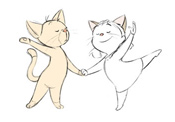 Hyun-Min Lee: Initially it started at school. At school we had to do a film to graduate. I always wanted to make a film about my mother and my memories of her because she passed away about eight years ago and animation seemed like the perfect medium. So I had an initial version of the film where it was much heavier and slow and it didn’t go so well with the faculty thinking I wouldn’t have enough time to make it so I rethought the project and made it a much lighter film, more about the happier memories of me and my mother. So I just made a really rough version for school, then after school I finished it.
Hyun-Min Lee: Initially it started at school. At school we had to do a film to graduate. I always wanted to make a film about my mother and my memories of her because she passed away about eight years ago and animation seemed like the perfect medium. So I had an initial version of the film where it was much heavier and slow and it didn’t go so well with the faculty thinking I wouldn’t have enough time to make it so I rethought the project and made it a much lighter film, more about the happier memories of me and my mother. So I just made a really rough version for school, then after school I finished it.
AV: The school being Cal Arts?
HM: Yes.
Jennifer Cardon Klein: She went to school for four years for painting, so Cal Arts was her Masters degree.
Bert Klein: When I first met Hyun-Min she was in the experimental program and I was teaching character animation and she was one of the students in my class and she was amazing. She hadn’t even really animated before, just a little bit.
HM: I’d spent a year in the Experimental Animation program at Cal Arts and the animation courses were very different there. It was doing cut-out animation, scratch on film, sand animation and even the drawn Animation wasn’t really about traditional character animation, it was a lot more like abstract art.
AV: Sounds like Flash animation.
BK: Yeah, but it was by hand. And in my class, the first exercise I did was I wanted to do a really simple character to animate that didn’t have a lot of detail so I gave the option to do either Bugs Bunny or Daffy Duck and I had Eric [Goldberg] record funny dialogue lines for both of the characters. So I gave the tracks out to everyone and part of the finishing was that once the students finished the test I brought Eric in to critique everyone’s test, which was a lot of fun, and it’s a separate story itself. So Hyun-Min did a test of Bugs Bunny pretty good and I noticed how accurately she drew. About that time while I was teaching at Cal Arts I was knee deep in my work as the lead animator on the Monkey’s Tale project that Eric was doing and we were on the finish line and I needed help because I had way too much work and couldn’t finish so…
AV: I remember that was really draining for you guys then [Goldberg previously spoke to Animated Views about the production of A Monkey’s Tale here].
BK: It was very draining. So I got some of my best students’ numbers and Hyun-Min was one of them. She even wrote down a reminder of what her test was. So she came here and helped do in-betweens on A Monkey’s Tale and they were amazing. It was great stuff. She’d never done charts before and learned all about charting by inbetweening on the Monkey’s Tale project.
AV: Sounds like a prodigy.
JCK: She’s been an amazing worker and she worked just as much as we did so we thought, “This must be a kindred spirit.”

Storyboard Art
BK: Then The Three Caballeros* came up. Eric had become a little familiar with Hyun-Min’s work, seen some tests that she did in the class, she did a Mickey test. At that point she’d become so advanced that I figured it was a bit of a waste to have her help me when I figured she could do scenes on her own. So I got another couple students to help me in her place. So I convinced Eric to give her scenes of her own to animate. So she did one and it was beautiful so he gave her another. So she did a great job on Three Caballeros but unfortunately it ate heavily into her time to finish her film. We helped get her on a schedule to get it done enough for graduation. But personally I felt terrible because I felt a little responsible, but at the same time she got great experience on Three Caballeros. But I promised her, since her project was such a special film, that when she graduated and got her degree we would take a look at the film and do whatever needed to be done to finish it to be exactly what it deserved to be. That leads us to the point where Don Hahn got involved.
JCK: We knew Don from work. Both Bert and I had worked at Disney but we had never actually worked on one of Don’s films. So we’d seen him over the years.
AV: But you had worked on Lion King, or at least the tail end of it…
BK: Yeah, I was going to say the closest I’d worked with Don was at the end of The Lion King.
JCK: So, Bert and I went out together one night and we’d been working on our own project (still upcoming at the time of this piece) and we bumped into Don and told him about The Chestnut Tree and asked him over to see it and he said, “Sure, I’d love to see it.” So he came over and was very generous and said, “If you need any help let me know.” So, when he got involved it was at the point where we were starting the color and starting to finish everything up and he came in as an outside point of view so he could see the film with fresh eyes. She’d been in the process of it for two years so we were all too close to the project and there were certain things we didn’t realize weren’t communicating. So, when he came in and saw that little hole, or the little story points that maybe weren’t pushed enough or weren’t communicating he was able to help us shape it into a better film even from that point where we thought we were doing pretty well, so that was a great addition that he made, coming on fresh and coming on with his experience to be able to see the whole big picture and figure out what the best and most efficient way to fix something was.
 And then he led us into the post process which is really complicated if you’ve never been through it. Most of us come trained in one department, so we’re trained in animation or effects or whatever. So we don’t go through the post process. Now, we ourselves have been through the post process before. But there’s a few steps Teddy Newton and I didn’t go through on Boys Night Out. So we learned from our mistakes. We didn’t do a real proper sound mix like we should have. We didn’t do a real color timing the way we should have for DVD, simply because that’s just the way we did things back then but Don had been through everything, through all the current technological advances, and he got a post production supervisor involved named Cory Hansen who had worked at Disney. So Cory led us through the whole process with Technicolor at Disney and it’s incredibly complicated coordinating the sound, the color timing, and everything, transfering from digital to film.
And then he led us into the post process which is really complicated if you’ve never been through it. Most of us come trained in one department, so we’re trained in animation or effects or whatever. So we don’t go through the post process. Now, we ourselves have been through the post process before. But there’s a few steps Teddy Newton and I didn’t go through on Boys Night Out. So we learned from our mistakes. We didn’t do a real proper sound mix like we should have. We didn’t do a real color timing the way we should have for DVD, simply because that’s just the way we did things back then but Don had been through everything, through all the current technological advances, and he got a post production supervisor involved named Cory Hansen who had worked at Disney. So Cory led us through the whole process with Technicolor at Disney and it’s incredibly complicated coordinating the sound, the color timing, and everything, transfering from digital to film.
AV: It used to be that you had to transfer from film to digital.
JCK: Yes, and a lot of this stuff it changes every year. New programs, new equipment, and you have no idea what’s going on so if we didn’t have Don record we would’ve been swimming in it.
BK: When Teddy Newton and I made Boys Night Out a few years ago there were lots of post problems because you make a lot of mistakes your first time out. So we might’ve made less on our own when we made The Chestnut Tree but with Don by our side it went very well.
AV: Were there elements that you didn’t even know about at all?
JCK: Definitely in the post process. Like the digital intermediary where you take the digital cells and you do a color timing, is that a good description?
BK: Yeah, when Teddy Newton and I did Boys Night Out we did our color timing off a Telecine which is off the film itself which, generally, you’re not going to get the best results that way. Nowadays they actually render out two different versions of the files. One is at a 35 and the other is specifically to assist them in the digital color timing, and we didn’t know about that. And, basically, little things like that end up helping us get a real good, pristine quality version of the film that looks great on anything really.
AV: And you were saying they let you use the facilities at Disney?
BK: Yep, who was it?
JCK: Joe Juiliano and Bill Fadness and their crew. That’s something we would’ve never had access to unless Don was our executive producer.
BK: Yes, and we had access to the same equipment that they output all of Disney’s features on. So it was good. We had a really nice, clean print.
AV: It looked very sharp.
JCK: Yep.
BK: Yeah, it’s funny because you can do stuff on your own nowadays, but unless you really have access to the really highest end equipment your final project will never quite come out looking quite as slick as stuff that you’ll buy in the store.
JCK: There’s a lot of tricks that you really have to know about.

Storyboard Art
BK: So once we finished the film it’s been having a lot of success at festivals. It’s been winning awards. It’s won awards at three festivals so far [including a 2007 LA Femme award]. And the latest is that it’s earned two Annie nominations, which we’re really excited about: Best Short and Best Production Artist [for Hyun-Min Lee]. Some of the special things about the film that we like people to know about is that it is entirely hand-drawn and it’s in a very personal style but it’s also very influenced by Eric. Well, the influence I got from Eric passed through me to Hyun-Min. Eric did contribute to the film in that me and him and Hyun-Min sat down at an early stage with the story reel and the music. The film is very carefully synched to music and through Eric’s guidance and a little bit of me piping in we figured out how to take a shot and export the musical possibility of each phrase of music to each shot and marry them together. Our Rhapsody In Blue experience really helped. So, literally, once we came up with the idea of, “Okay, this musical flourish will be like this twirling, or this musical hit will be this character falling down, etc,” Hyun-Min then later transcribed the music on to exposure sheets, basically for her own notation, treating the music like dialogue, and then animate the scenes to that. I’ve been working with Eric for fifteen years and everything Eric likes to do is to have clarity and meaning. And that’s pretty much what we tried to do every step of the way and we tried to achieve it with The Chestnut Tree.
AV: One thing that I noticed while watching it is that it has that same quality that Al Hirschfeld said he saw in Aladdin: it all seemed to have been drawn by one hand.
JCK: Well, Hyun-Min is very exacting.
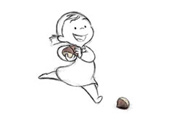 AV: Another thing about it made me think of was the Peanuts comic strip, where in the 50s its art was very tight and in the 60s and 70s it was rather loose, but in the 80s and 90s, up until it ended, Charles Schulz had this masterful way of making his art for the strip loose and tight at the same time. Does that make any sense?
AV: Another thing about it made me think of was the Peanuts comic strip, where in the 50s its art was very tight and in the 60s and 70s it was rather loose, but in the 80s and 90s, up until it ended, Charles Schulz had this masterful way of making his art for the strip loose and tight at the same time. Does that make any sense?
HM: Yes.
BK: Absolutely. That’s what we strive for as animators and some of the absolute masters are that way. With the current project that we’re working on we collaborated very closely with Mark Henn. He has tremendous experience and his work is loose and tight at the same time because he draws so well. Eric is interesting, he’s such a strong draftsman that he can draw in any way he’s asked. And Ollie Johnston’s work is a perfect example of that. If you look at any of Ollie’s roughs they’re definitely loose and tight at the same time.
HM: Mark gave some guest lectures at Cal Arts and said that Ollie always stressed not to draw clean but to draw clear.
AV: Now you mentioned before that you took the painting courses before you started learning animation in-depth and that kind of makes me think of Glen Keane who wanted to get into painting but wound up in animation, so now he has both those subjects in his background.
BK: Hyun-Min was in my class and was a standout student. One of the things that set her apart from the others was that Hyun-Min was trained in the fine arts before going to Cal Arts.
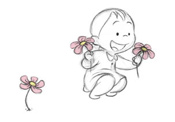 JCK: And we saw a significant advancement when compared to the other students when it came to her draftsmanship. When we first started working with her it made me think of the old animators, who in the 30s went to art school first before they ever went to Disney.
JCK: And we saw a significant advancement when compared to the other students when it came to her draftsmanship. When we first started working with her it made me think of the old animators, who in the 30s went to art school first before they ever went to Disney.
AV: Like with Marc Davis…
JCK: Yeah. All these guys went for art training for two or four years before they ever started animating and you see it in their work; you see it in the painting and the development art and the animation and we don’t have that anymore. You go to Cal Arts and it’s still an art school, actually more so than Wesleyan is…maybe it’s just that some people go there straight out of high school?
AV: Right out of high school and you’re starting in animation.
JCK: Yeah. And you don’t have those years to mature as an artist. I think Hyun-Min actually has a great advantage.
HM: Something that I thought might be an influence on me is that I grew up in Korea and the art surrounding me was Asian art and also Korean and Japanese cartoons. Asian art is more line-based, in a way; it’s all about the lines. So basically when I was growing up I did drawings without shading and would draw kind of rough with a pencil and then go over it and clean it up. In all the art classes in Korea they make sure they put in a calligraphy class and in art school they make you use cross-hatching techniques so I had a sketchbook full of just straight lines vertically, straight lines horizontally, curved lines, diagonal lines…that kind of training.
AV: Pretty rigorous.
BK: That’s the thing. When she had that rigorous training I think that helped her shoot ahead of the rest of the class.
AV: There’s this paradox with animation: when you’re watching it it’s this fun, lively, spontaneous thing, but then you look at the process of it and the training people go through, and the work that goes into it, the blood, sweat and tears. You all know better than I do, of course!
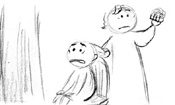
Storyboard Art
BK: But if the audience is entertained and they don’t see the blood, sweat and tears then you know you’ve done your job. They’re supposed to just enjoy what they’re watching. And that’s why so much care is taken in trying to not make any technical errors.
AV: Before you got here, Hyun-Min, we were talking about the films you were up against for Annies. That could be intimidating since you’re up against a couple Disney things and a Pixar short.
BK: It’s always intimidating when you’re up against the big studios because a lot of the time when it comes time to vote you’re not sure if the voters have even seen your offering. But we believe this is a special film and, in my opinion, some of the most beautiful hand-drawn animation I’ve seen.
AV: From what I know about the batch of nominees it sounds like yours has more of an emotional core.
BK: That’s one of the reasons why it’s so special. That’s why Jennifer and I decided to come on board and work with Hyun-Min and produce the film, because films with this emotional core don’t happen very often.
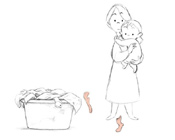 JCK: And it’s also rare to find an animator who can do story, because a lot of times animators are not in story for a reason…they have to animate. But Hyun-Min could do both and make the story sweet and pure and personal.
JCK: And it’s also rare to find an animator who can do story, because a lot of times animators are not in story for a reason…they have to animate. But Hyun-Min could do both and make the story sweet and pure and personal.
AV: Now when it’s that personal you have to trust everyone else involved…
BK: There were some dark times. It was a very emotional process. And Don definitely played an important role in keeping us going toward the best film possible.
HM: And if Bert and Jen told me something should be changed, I had worked with them for quite a while and I knew they knew me very well, so I trusted that the advice they gave was important for the good of the film.
AV: Do you have any plans for distribution?
BK: Right now we are doing the festival circuit.
JCK: And we have two years to do as many festivals as possible. Then after that usually something will pop up. We’ve had a few offers, a few people e-mail us. People put together compilations. In Europe they screen shorts on the TV all the time as program filler, in between programs.
AV: I like that idea.
JCK: They don’t do it as much here but on the cable stations sometimes they do.
BK: But because of the rules at many of the festivals you’re supposed to wait before you allow your short to be included on a compilation or else you get disqualified. So we do an obligatory festival run first.
JCK: Another thing about Don that we found out is that he has a degree in music so he would catch little things and say something like, “That’s two frames off.” And we would think, “No, it’s not.” Then we would look at it more in-depth and realize he was right.
BK: Don worked on several music-based shorts such as Lorenzo, and One by One, and The Little Matchgirl, and he was heavily involved in Fantasia 2000. But, yeah, we were too close to the film so we’d seen many scenes several times and they looked fine to us but Don would say, “No, it’s off.” So he really helped make this small little gem of a film just what it needed to be.
AV: The Chestnut Tree is kind of a gift to your mother, isn’t it? Saying that you’ll always remember her and that she’ll always have an influence on you…

Storyboard Art
HM: Yes, and also a gift to the rest of my family.
AV: It was active and it kept you interested but it didn’t bang you over the head. The pacing was good. Any last words?
BK: Well, we are animators and we work day jobs and we love our jobs but we also have to have this thing on the side where we really can do whatever we want and make projects happen and we’re going to continue to do it.
JCK: I just think it’s a great example of 2D animation. And it’s a great example of the mentor/apprentice relationship and how things can be passed down to these guys, and just being able to animate everything in 2D, in pencil.
AV: In pencil, on paper?
BK: Yes, in pencil on paper and scanned one at a time. In most 2D animation the cleanup is done very accurately so the ink and paint process is very easy, just click and fill. But since these drawings were very loose we had to do a lot of painstaking frame-by-frame process. We had to take a brush and color over each area one frame at a time so it wasn’t the easiest to achieve, but we’re very happy with it!
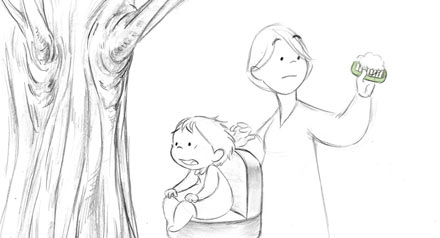

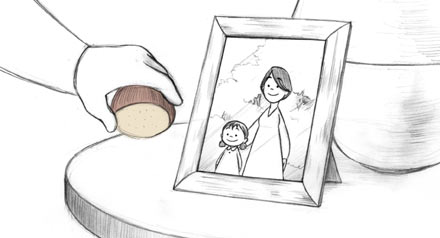
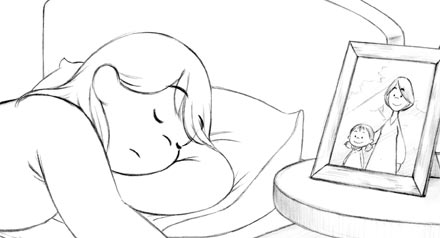
*The Three Caballeros refers to the animation completed early last year that was used on the Gran Fiesta Tour boat ride in the Mexican pavilion at Walt Disney World’s Epcot Center. Boys Night Out is available for download at Cartoon Brew Films.
With our extreme gratitude and appreciation to our interview participants Hyun-Min Lee, Jennifer Cardon Klein and Bert Klein, as well as Eric Goldberg and Don Hahn. The Chestnut Tree is now playing festivals worldwide and has been twice nominated in the 35th annual Annie Awards, to be presented on Friday February 8 at UCLA’s Royce Hall in Los Angeles.





